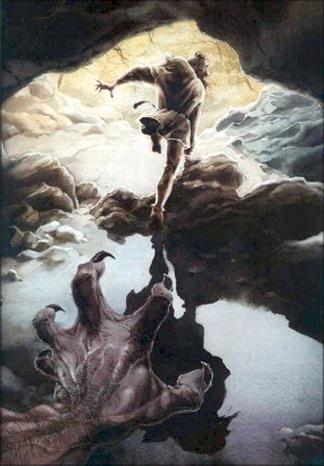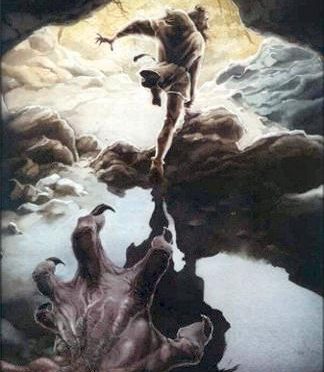One of my favorite myths from the Basque Country involves two brothers and their teacher Etsai. Teaching from the depths of his cave, Etsai was a renowned teacher and many students came to learn from him, including the brothers Axular/Atarrabi and Mikelats. Axular essentially sacrifices himself for Mikelats’s freedom, but Mikelats becomes the bad brother. I guess complex family dynamics are as old as time.

- Etsai was a teacher who lectured from his cave Leixa, in Sara. Sometimes he taught from the cave in Zugarramurdi. He was master of many subjects, including science and the arts. However, he was also the devil, the enemy of humans (etsai literally means enemy or devil in Basque). Actually, many malevolent spirits are called Etsai. When students entered his tutelage, they learned many great things, but there was a price. One always had to stay behind and serve Etsai as payment.
- There are various legends of brothers who went to study with Etsai and some of them become intertwined. Atarrabi, the good son of Mari, and his bad brother Mikelats went to study. So did Axular and his brother. The details shift, but the general theme of these stories is similar.
- Axular and his brother, along with a few other friends, went to the caves in Zugarramurdi to study with Etsai. When their studies were complete, it befell on Axular’s brother to remain behind and become Etsai’s servant. Axular took pity on his brother and swapped places with him, remaining to do Etsai’s bidding. Etsai had him work constantly at pointless jobs. As one example, Axular was forced to extract water from a pond with a pot whose bottom was a sieve. Axular grew tired of the endless and demeaning tasks and tried to escape. And he nearly did. As he ran out of the cave, Etsai threw an iron hook at him, and just snagged his heel. Axular escaped, but without his shadow – his very soul – and his heel, which remained in the domain of Etsai.
- Etsai, furious, wanted more than Axular’s shadow. Axular became a local priest. Etsai tricked a local cowherd to deliver a package to Axular, telling the man he would then help him find his missing cows. Axular was wary of a trick; he opened the package, revealing red belts or ribbons. He asked the cowherd to wrap them around a nearby tree. Immediately, the ribbons encircled the tree, constricting it until it fell.
- Axular’s, or Atarrabi’s, brother Mikelats had been freed when Atarrabi had taken his place under Etsai’s control. Even so, Mikelats was malevolent. Once, after Atarrabi/Axular had been freed, he encountered his brother. Mikelats tried to destroy the local wheat fields, presumably to harm Axular and his home, but Axular, ready for the attack, flicked his foot, flinging his shoe in the air, and thus disrupted the approaching storm.
- As Axular approached death, that he didn’t have his shadow – his soul – weighed on him. Only when he performed mass would his shadow return to him, so he resolved to die in the middle of mass. He asked his sacristan to kill him during the next mass. The sacristan was afraid and, when the time came, refused to kill the priest. He refused the next day as well. But, with enough pleading, Axular convinced him and on the third day the sacristan killed the priest, saving him and his soul.
- There was a real Axular, or Atxular, who was a priest in the region of Sara during the early 1600s. Born in 1556, Pedro de Aguerre was from a house named Atxular. He gained fame for writing the important work Gero (you can find it here). His fame inspired some of the legends of Axular.
Primary sources: Barandiaran Ayerbe, José Miguel de. Axular. Auñamendi Encyclopedia. Available at: https://aunamendi.eusko-ikaskuntza.eus/en/axular/ar-16352/; Etsai, hiru.eus; Barandiaran Ayerbe, José Miguel de. Mikelats. Auñamendi Encyclopedia. Available at: https://aunamendi.eusko-ikaskuntza.eus/en/mikelats/ar-95812/
Discover more from Buber's Basque Page
Subscribe to get the latest posts sent to your email.



One thought on “Basque Fact of the Week: Etsai, Axular, and Mikelats”